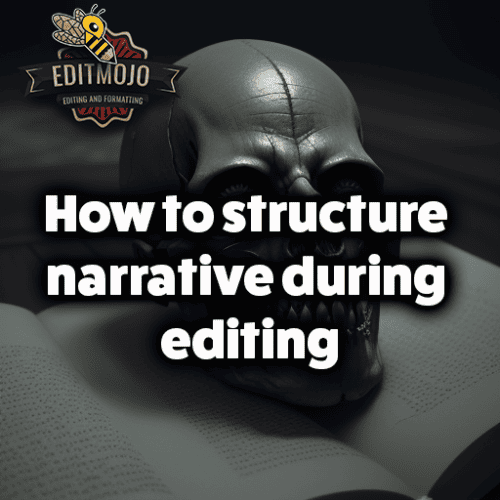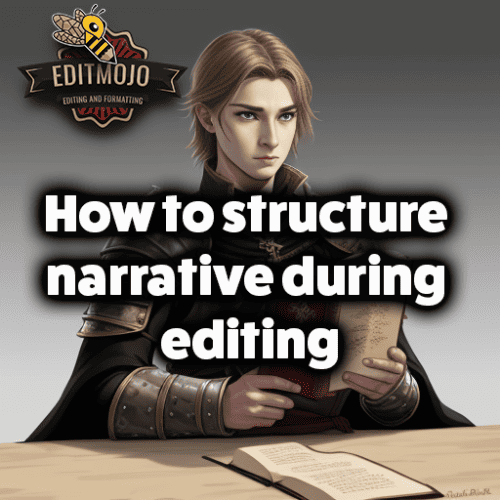How to structure narrative during editing
How to structure narrative during editing. The craft of storytelling is akin to weaving. You begin with a jumbled pile of threads – characters, plot, setting, themes, and emotions. The real magic lies in how you weave these threads together. This is where narrative structure comes into play.
Just as a skeleton gives the body shape and function, narrative structure gives a story its form and movement. It dictates how the reader experiences the tale, controlling the ebb and flow of suspense, emotion, and information. Editing, on the other hand, is the process of refining and reshaping this structure to its finest form. An edited narrative is a polished gem, a woven tapestry, a dance choreographed to perfection. Let’s embark on a journey to explore this integral part of storytelling.
Key Takeaways Table
| Key Points | Details |
|---|---|
| Understanding Narrative Structure | Narrative structure is akin to a skeleton for your story, guiding its form and movement. Understanding and choosing the right structure for your story is key. |
| Role of Editing in Narrative Structure | Editing is the refining process for your narrative structure. It’s where you step back, view the narrative from a reader’s perspective, and shape it accordingly. |
| Techniques for Structuring Narrative in Editing | Techniques include plot evaluation, character development check, pace and tension analysis, and theme coherence. Each helps refine the narrative structure. |
| Tools for Structuring Narrative in Editing | Tools range from traditional ones such as storyboarding and color-coding, to modern ones like editing software and apps. |
| Overcoming Challenges in Structuring Narrative | Challenges include plot holes, character inconsistency, pacing issues, and theme consistency. Viewing them as opportunities for improvement rather than obstacles can aid in overcoming them. |
| Role of External Feedback | Beta readers and professional editors provide valuable external perspectives that can help refine the narrative structure. |
Understanding the Basic Narrative Structure
Consider the structure of a story as a mountain. This is the simplest form of narrative structure – often called the dramatic arc – comprising five elements: introduction, rising action, climax, falling action, and resolution^1^.

The introduction is like the mountain’s base, grounding the reader in the story’s world and characters. The rising action is the mountain’s slope, a climb in tension or conflict. The climax is the mountain’s peak, the moment of highest tension. The falling action is the downhill journey, a release of tension and resolution of conflict, while the resolution is the calm plain, where the story finds its closure.
But just as mountains differ in shape and size, so too can narrative structures. Some narratives are non-linear, jumping between past, present, and future^2^. Others are circular, ending where they began. Yet others spiral, repeating but always moving forward. As an author, your challenge is to choose and craft the structure that best serves your story.
The Relationship Between Narrative Structure and Editing
Editing is the crucible in which your narrative structure is tested and honed. It’s a chance to step back, to see the narrative as a reader would, and to refine it accordingly. It’s the perfect opportunity to make sure the shape of your story aligns with its content.
Imagine you’re a sculptor. Your first draft is a block of marble. Editing is the process of chipping away at that marble until a statue – your story – emerges. You look at it from all angles, make sure it’s balanced, and polish it until it shines. That’s what the editing process does for your narrative.
Tips for Structuring Your Narrative During Editing
Plot Evaluation
During the editing phase, you need to examine your plot with a critical eye. Outline your story, noting major and minor plot points. This ‘plot skeleton’ can help you see where your story might be lacking meat or where it might be too bulky.

Look for gaps in your plot or inconsistencies. Is there a sudden jump from point A to point B that leaves the reader disoriented? Is there a subplot that leads nowhere? If a reader were to ask why something happened, would you have an answer? If not, you’ve got some editing to do.
Character Development Check
Characters should be living, breathing people who change and grow. Do your characters evolve over the course of the story? Does this evolution feel natural, or is it forced?
Ensure your characters serve the plot effectively. If a character could be removed without significantly impacting the plot, consider whether they’re necessary or if they need more development.
Pace and Tension Analysis
Your story should be like a roller coaster ride, with highs and lows that keep your reader engaged. Consider the pace of your narrative. Is it a steady climb, a series of peaks and valleys, or a flat ride with no ups and downs? Different stories require different pacing, but a story without variation risks being monotonous^3^.
Theme Coherence
What message do you want your reader to take away from your story? Make sure your theme is conveyed consistently throughout the narrative. If you’re writing about the power of friendship, but your characters are constantly backstabbing each other without consequence, your narrative structure might need some tweaking.
Tools and Techniques for Structuring Narrative During Editing
There are many tools at your disposal to aid in structuring your narrative during editing. Storyboarding and plot outlining can help you visually see your narrative structure^4^. Color-coding and annotation can be useful for tracking character arcs. Beat sheets can help ensure pacing and build tension. Mind maps can be used to trace and analyze your theme.
Modern editing software and apps are also incredibly helpful. Tools like Scrivener or ProWritingAid offer features that can aid in structuring your narrative[^5^].

Common Challenges in Structuring Narrative and How to Overcome Them
Every author faces challenges in crafting a compelling narrative structure. Plot holes, inconsistencies, imbalanced character development, maintaining pace, and keeping the theme consistent are common hurdles.
Overcoming these challenges is a part of mastering the craft of storytelling. Learn to see these challenges not as obstacles, but as opportunities to improve your narrative. Each challenge overcome is a step closer to a more engaging, satisfying story.
Case Studies: Successful Narrative Structure Editing
Analyzing popular works can provide valuable insights into how narrative structures were likely shaped during editing. For example, consider George R.R. Martin’s A Song of Ice and Fire series^6^. The narrative structure shifts between characters chapter by chapter, providing a multi-faceted perspective of the unfolding events. This structure heightens tension and anticipation as readers navigate the intricate political landscape of Westeros.
The Role of Beta Readers and Professional Editors in Structuring Narrative
Beta readers and professional editors provide an external perspective, vital in identifying narrative structure issues. They can help spot plot holes, character inconsistencies, pacing issues, and thematic dissonance that you might miss. Just like a sculptor benefits from an outside opinion on their statue, an author benefits from outside opinions on their narrative.
Conclusion (How to structure narrative during editing)
The structure of your narrative is the spine of your story. It’s what shapes your tale and guides your reader through the world you’ve created. Mastering narrative structure is a complex, rewarding task, but remember: your first draft doesn’t have to be perfect. The beauty of editing is that it allows you to reshape, refine, and perfect your narrative structure. So go forth, brave writer, and shape your stories until they shine.
Top Five Questions and Answers Table
| Questions | Answers |
|---|---|
| What is narrative structure? | Narrative structure is the sequence in which a story’s events are organized to make a cohesive story. |
| Why is structuring narrative important during editing? | Proper narrative structure keeps readers engaged, allows for effective pacing, character development, and theme exploration, all of which are refined during editing. |
| What tools can help structure a narrative during editing? | Tools include storyboarding, color-coding, beat sheets, mind maps, and editing software like Scrivener and ProWritingAid. |
| How can I overcome challenges in structuring narrative? | You can overcome challenges by seeing them as opportunities for improvement, using tools and techniques effectively, and seeking feedback from beta readers or professional editors. |
| Where can I learn more about narrative structure and editing? | There are numerous books, courses, and online resources available for learning more about narrative structure and editing. Refer to the “Additional Resources” section for some recommendations. |
Top Five Resources and Further Reading Table
| Resources | Keywords |
|---|---|
| Story Engineering by Larry Brooks | Story Engineering, Larry Brooks |
| The Anatomy of Story by John Truby | The Anatomy of Story, John Truby |
| MasterClass | Online courses, Writing Masterclass |
| The Write Practice | Non-linear narrative, Writing tips |
| Writer’s Digest | Pacing a novel, Writing tips |
